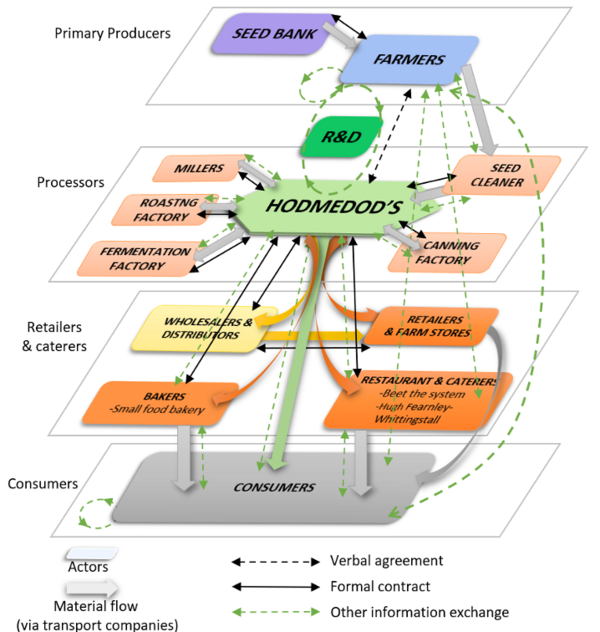Based on case study 15 - Growing pulses and innovative crops for a less resource-intensive diet, we conducted a value chain analysis of fava bean-based food from the British company Hodmedod’s. The study was carried out by the Organic Research Centre (ORC) and Wageningen University. This analysis shows how activities within the fava bean food production value chain in the UK promote novel foods. We analysed the data in terms of network structure, value addition and governance structure. Then we examined the motivations of participants in the value chain.
The results show that in terms of the network structure, actors involved in production are linked via their connection with Hodmedod’s. However, the downstream network follows the three types of market channels: direct online sales, catering supplier channels and selected distributor channels (Figure 1).
The added value is generated through product-related activities, for example, organic certification, distribution management, co-learning processes among actors, and value-added information provision.
Governance between farmers and Hodmedod’s is based on trust and verbal commitment, allowing complex knowledge exchange and balanced power relationships. We also identified that fava beans were being decommodified. By linking the products to other priority issues such as environmental sustainability, Hodmedod’s distinguishes their products from the general fava beans commodity.
Farmers’ motivations for growing fava beans are fundamentally for agronomic and environmental benefits and better long-term financial performance. An interest in supplying the beans for human consumption in local markets drove the farmers to collaborate with Hodmedod’s. Their initial vision was to promote British-grown pulses and lay the market foundation for novel crops. Hodmedod’s increased motivation by raising awareness of sustainable consumption and amplifying the benefits of crop diversification. The openness of information exchange, combined with shared environmental motivations among participants, stimulates innovation in product development.
Supply chain instability caused by insect damage and the lack of organic fava beans suppliers were the major constraints for production. Although different post-harvesting techniques used for pulses might influence the establishment of a production line, the communication strategy and distribution channels of Hodmedod’s can still act as a reference for other enterprises to promote novel pulse-based food.
Overall, fava beans as an alternative protein source to meat have bright commercial prospects as they fit the trend of sustainable consumption. However, promoting fava beans for food consumption still needs a concerted effort by actors in the whole value chain. As a next step, the value chain approach will be applied to other DiverIMPACTS case studies with different levels of value chain development and impact for crop diversification.

 tap and then scroll down to the Add to Home Screen command.
tap and then scroll down to the Add to Home Screen command.